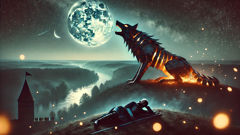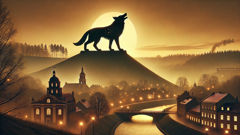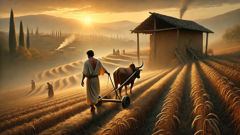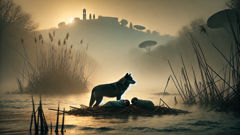Introduction
On a wind-darkened slope above a slow, silver river, a tired ruler slept at last. The air smelled of wet earth and spruce, the kind of cold that made wool and iron feel like separate comforts. Grand Duke Gediminas had ridden out from his wooden hall with the weight of tribes and enemies on his shoulders, seeking a horizon where he might plant a capital that could shelter people, horses, and destiny alike. He laid himself upon a plank of fur and bark, beneath an open sky thin with stars, and the river nearby moved with the hush of old water telling old things. In the hold of that half-sleep, when the world thinned and meaning sharpened, he dreamed: a wolf, but not a mere beast. It was iron—scaled like a kettle and ringed like chainmail—its hide clinking faintly like a smith’s workshop at dawn. The wolf stood upon a moonlit hill and howled a sound that was neither wholly animal nor wholly music; it carried over the water and up the valley and struck the duke like an answer to a question he had not yet voiced. The dream grew vivid—flames around the wolf where paws met grass, sparks that rose and fell like falling stars. Then an old man, weathered by winter and laughter, spoke to Gediminas in the dream: build a city where the wolf howls, he said, and a great people will live there. The iron wolf’s call is a promise, and the land will remember that sound as its name. When the duke woke, the dream lay in him like a seed: small, bright, and impossible to ignore. He ordered his men to find the place that answered the wolf’s cry, and from that single vision a capital would rise—Vilnius, a city whose stones and churches and crooked streets would be given shape by the echo of an iron howl and the stubborn hands of those who heard it.
The Dream and the Cry
Gediminas had been a ruler of motion. His life passed through forests and borderlands where alliances were forged with flint and exchanged for horses. He listened to bards and envoys, to farmers who brought reports of floods and wolves, to princes who offered gifts and threats in equal measure. The northern nights pressed in with long silence and the piercing clarity of stars, and it is under such skies that legends begin: when people notice meaning in the dark and shape it into a voice. The Iron Wolf legend opens in the kind of liminal hour where the ordinary and the extraordinary touch.

The dream itself is spare in surviving accounts but enormous in its consequence. Imagine Gediminas at peace for the first time in many nights, his back against rough boards, cloak drawn tight, the sounds around him reduced to the essential rhythm of breath and water. Into that rhythm a howl arrives: a sound like iron struck on stone, like a bell muffled by distant mist, like the combined calls of every wolf in the wood. The wolf of his vision is not wild furred flesh alone; it is forged to the world, as if an itinerant smith of the gods had hammered a guardian into being. Heroes and rulers dream of signs—stars, birds, omens—but the iron wolf is a foundation myth that insists on form: it is a creature of both nature and craft. This union mattered to the people who would build Vilnius, because they were creatures of axe and plow as well as hikers and hunters, and they would need both wildness and workmanship to make a lasting city.
When Gediminas woke, the dream did not recede like morning mist. It pressed against his mind with the gravity of an order. He summoned interpreters, wise men, and priests; he sought the counsel of those who read the movements of animals and the voices of neighbors. Yet the message was plain enough even to men unused to omens: seek the place where the iron wolf howls and found your town there. It was not merely a direction but a prophecy of sound—an odd kind of instruction that tied place to noise, and noise to fate. Scholars later have suggested that the image of an iron wolf might be a metaphor for strength and permanence, a symbol of protection as much as of wild ferocity. But in the telling passed down among villagers and chroniclers, it remained vivid and specific: a wolf, iron, a howl that echoes across the valley.
The cultural texture of medieval Lithuania helps explain why such a dream gripped both ruler and people. In that era, the region sat at the nexus of pagan rites, emerging statecraft, and the movement of ideas and goods across the Baltic and the Eastern European plains. A leader like Gediminas needed symbols he could point to—tangible images that would hold the loyalty of diverse tribes. The iron wolf served as a unifying image. It could be invoked in counsel and carved on doorway lintels, its story repeated during feasts and funeral rites. The howling of the wolf spoke to a primal human instinct: the call that gathers, warns, and announces presence. A capital must announce itself.
Oral tradition adds layers: in some local tellings, the wolf's howl attracts the people, the buzzing life of markets, blacksmiths, and craftsmen; in others, the iron wolf stands guard against enemies, its iron body a deterrent to invaders. There is a fundamental ambiguity—an artful duality—embedded in the legend. The wolf is both summoner and sentinel. That ambivalence maps onto the city that grows from the dream: Vilnius becomes a place of bustling trade and careful fortification; a city of churches and defensive earthworks, of open markets and secret councils.
Even as the story softens into myth, you can imagine the practical steps that followed for Gediminas. He would walk chosen ridges and call his men to listen; he would watch how the river folded light and how the forest funneled sound. He may have chosen the hill not because a wolf's cry literally rang there but because the geography made the place feel like it could hold a city's聲 collateral—its echoes would reach valleys and lanes, its approaches could be controlled, its resources gathered. Yet the name the people put to the moment—an iron wolf's cry—remained poetic. Names often outlive the reasons for them, and it is through naming that the ordinary is sanctified. Vilnius, which later takes its name from the river Vilnia, keeps that sanctifying story as a founding myth, a way to remember that the city's first blueprint was not soil and timber alone but also a sound and a dream.
The Iron Wolf legend also became a measured account of identity. During centuries of shifting borders, religious changes, and political pressures, myths about origins function like anchors. For Lithuanians, who navigated periods of pagan practice and Christian conversion, occupations, and renaissance, the image of Gediminas' wolf could be called upon to explain endurance and moral claim to the land. It distills a narrative: a ruler dreamed a protective beast and built a city; the city withstood time because its founding had a prophetic quality. A dream conferred legitimacy. Leaders elsewhere in history have used visions and omens to legitimize projects and to bind peoples to a shared past; in Vilnius, the Iron Wolf served that role with particular resonance.
Stories change as they cross generations. Ballads elongate images; scribes add details that make for a finer story. In manuscripts, chroniclers wrote of envoys who later carried word of the wonder to foreign courts; in taverns, storytellers argued over whether the iron wolf's eyes burned with blue flame or whether its teeth rang like coins. Yet at the center endures the same kernel: a night of listening and a howl that promised a city. That kernel has also proven elastic. In some retellings, the wolf is a test, drawing forth the brave. In others, it is a pact with the land. Modern artists and sculptors have made the wolf into monuments, paintings, and motifs, each reinterpretation a new conversation with Gediminas' night. The durability of the image says as much about the human need for stories that speak to place as it does about the historical act of founding a capital.
Furthermore, the iron wolf legend occupies a particular niche in the interplay between myth and archaeology. Excavations near the heart of Vilnius have uncovered layers of past settlements: postholes from wooden structures, remnants of charred grain, and traces of early market activity. None of these speak in silver howls, but they corroborate a city that grew from practical choices—water, defensible hills, and fertile land. The dream mattered because it created a narrative to unify those choices into a destiny. A good founding story can catalyze migrations and investments; people choose to build where a story calls them to belong. Today's traveler who walks the serpentine lanes of Old Town might pass under towers and wonder whether they are tracing steps first set down because of a dream. The Iron Wolf gives those steps a soundscape: every footfall an echo of an ancient howl.
Legend invites interpretation and celebration. Parades, pageants, and festivals have kept Gediminas' vision alive, not as a literal history but as a cultural touchstone. Children hear the story in school; artists riff on it in exhibitions; a statue on a hillside stands like a punctuation mark, reminding citizens and visitors alike that Vilnius began not only because of timber and toil but because someone once heard an extraordinary sound and decided to answer it. In a land where forests and rivers shape the imagination, the iron wolf's bark persists as a clear voice: a reminder that places are made by much more than stones—they are made by the stories we tell about them.
From Dream to Stone: Building a Capital
The path from an imagined howl to streets of stone is rarely direct. Founding a capital requires logistics, labor, politics, and a measure of good fortune. In Gediminas' time, those things were managed without modern infrastructure but with a kind of practical improvisation honed by generations of life on the land. The legend compresses that improvisation into a dramatic arc: a leader hears a sign, selects a place, and sets workers to raise walls and roofs. Underneath the compressed myth is a slower reality of clearing land, hewing timber, setting palisades, and coaxing settlers with promises and protections. The hill where the wolf had sounded—later called Gediminas Hill—offered both symbolic and strategic advantages. It overlooked the convergence of valleys and waters, permitting watchers to see approaching travelers and foes. It possessed soils good enough for gardens and fields and access to forests where wood and game could be gathered. Such practicalities would determine where people lived, but the dream supplied a moral and cultural license to gather there.

The early town that grows from Gediminas' choice is not a single coordinated blueprint but a mosaic of hamlets and craftsmen's yards that circle a defensive mound and fortification. Blacksmiths come quickly—this is important, as a place that claims a forged iron creature in its origin story must itself be a locus of metallurgy and craft. The blacksmith's sparks, the rhythm of hammer on anvil, becomes the city's auditory signature for the first generations, resonating with the echo of the iron wolf. Markets blossom along the river where boats bring salt, furs, and grain from distant lands. Traders who had once skirted the wild edges of the Lithuanian wood now find reason to stay. Churches and pagan groves occupy different corners of the cityscape as religious identities evolve and negotiate space. The process is one of layering: wooden dwellings give way, over centuries, to stone foundations; earthen ramparts are rebuilt with masonry; narrow lanes widen into planned streets.
A ruling center also needs institutions of law and command. Gediminas, portrayed in later chronicles as shrewd and expansive, understood how to anchor loyalty through grants of land, rights, and privileges. He lured artisans, priests, and merchants with a combination of law and legend: the promise of protection under the duke’s banner, and the promise of a place whose very name was blessed by a prophetic howl. In time, a castle perched on the hill would signal defense and authority. Towers would house watchmen and keepers; cellars would hold grain to tide a town through famine and siege. The medieval city thus emerges as both a practical hub and a performative space—a place where the myth of origin is re-enacted through festivals, official oaths, and commemorations.
Language and names play their role. The river that cuts through the valley is Vilnia, and through natural shifts of tongue and time the settlement's name becomes Vilnius. Etymology and legend entwine: the river gives the place a physical name while the Iron Wolf story endows it with narrative meaning. People like names that contain stories because names can be invoked to explain territory and rights. When envoys and traders arrived from other courts—Polish dukes, Teutonic envoys, merchants from Hanseatic ports—they encountered a city that declared itself through its architecture and its tales. The legend of the iron wolf became a kind of diplomatic shorthand: here is a people who believe in their land, who place a dream at the center of a civic identity. That was persuasive in both practical and symbolic terms.
The centuries after Gediminas' founding show the city negotiating forces and reinvention. Vilnius grows into a cultural capital where scholars copy manuscripts, where builders raise churches that become cross-cultural repositories of art and faith, where markets hum with the exchange of ideas as much as of goods. Each new layer of walls and each new bell tower converses with the original story. The Iron Wolf remains, now no longer confined to dream but cast into monuments, coins, and household legends. In times of siege, citizens might imagine the wolf standing guard; in times of peace, they imagine it howling a call to prosperity. This flexible symbol allows the city to absorb history rather than be crushed by it.
A remarkable aspect of Vilnius' endurance comes from how the legend and the city's physical evolution feed one another. Pilgrims and travelers bring back stories of the wolf; scribes record variations that emphasize different moral lessons—some lean on courage, others on destiny, some on cunning negotiation. Artists produce paintings and sculptures rendering the wolf in styles that reflect their eras: Renaissance painters give it a muscular, humanized gaze; folk artists carve more elemental forms of a guardian; modern sculptors sometimes render it in abstracted steel. Each image updates the myth for contemporary viewers, ensuring its continued relevance. Public memory is not fixed; it is constantly curated through ritual and art.
Modern Vilnius is a city of cobbled streets and neo-Gothic spires, Soviet-era blocks and gleaming new developments. Tourists wander Old Town, declared a UNESCO World Heritage site, where medieval alleys twist toward gates that once opened to markets and musters. The Iron Wolf story is marketed with care: tour guides narrate Gediminas' dream; museum exhibits juxtapose archaeology with legendary sketches; souvenir shops sell small iron wolf figurines as talismans. Yet the legend does more than sell postcards. For locals, it remains a touchstone of identity. During national celebrations and quiet winter nights alike, the story functions as a reminder that their city was conceived in a moment of listening, and that listening remains part of civic life.
Even now, when contemporary planners consider urban renewal, the echo of the wolf can be heard in debates about what kind of city Vilnius should be: a place of guardianship that protects vulnerable neighborhoods, or an open market city that invites trade and entrepreneurship? The dual nature of the iron wolf—both protector and clarion—offers an apt metaphor for such conversations. In pragmatic terms, city designers consider river management, historical preservation, and the needs of new residents; in symbolic terms, citizens ask whether the city will remain true to a founding spirit that called for resilience and welcome. These are the living questions of a city that began with a howl.
What, then, is the legacy of Gediminas' dream? It is more than a colorful anecdote; it is a cultural engine. It gave a name to a place and a reason to believe in that place. It knitted together story and topography, memory and map. It turned a hill into Gediminas Hill and a statue into a shrine. And by doing so, it taught a practical lesson about how people come to inhabit spaces: they arrive because someone calls them, and they stay because they can imagine themselves as part of a narrative larger than their private needs. The Iron Wolf is a call that invited a city to answer, and the city's long life is its reply.
Conclusion
Legends survive because they continue to speak to real human concerns. The Iron Wolf of Vilnius is not merely a quaint founding tale; it is a story about listening for guidance, about translating a vision into ordered life, and about the ways a community fashions identity out of image and place. Gediminas' dream transformed a ridge and a river into a living city whose stones remember both the practical labors of carpenters and the mythic howl that called people to gather. Today, when visitors climb Gediminas Hill or drift along the Neris, they walk through a palimpsest of eras: pagan rites, medieval markets, renaissance art, and modern civic debate. The wolf's iron echo has been repurposed time and again—by artists, by rulers, by ordinary citizens seeking belonging—but it remains meaningful because it binds a people to a story that makes sense of the land and of collective ambition. In the end, Vilnius stands as an answer to a dream: where an iron wolf once howled, a city answered with roofs and workshops, bells and books, a past that was shaped into a future that keeps being written.













